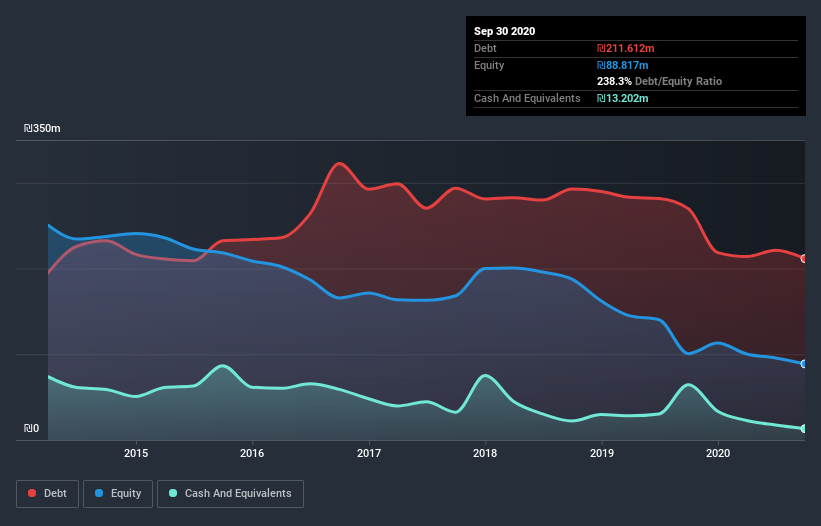David Iben put it well when he said, 'Volatility is not a risk we care about. What we care about is avoiding the permanent loss of capital.' So it might be obvious that you need to consider debt, when you think about how risky any given stock is, because too much debt can sink a company. We can see that C. Mer Industries Ltd. (TLV:CMER) does use debt in its business. But is this debt a concern to shareholders?
Why Does Debt Bring Risk?
Debt is a tool to help businesses grow, but if a business is incapable of paying off its lenders, then it exists at their mercy. In the worst case scenario, a company can go bankrupt if it cannot pay its creditors. However, a more usual (but still expensive) situation is where a company must dilute shareholders at a cheap share price simply to get debt under control. By replacing dilution, though, debt can be an extremely good tool for businesses that need capital to invest in growth at high rates of return. When we think about a company's use of debt, we first look at cash and debt together.
Check out our latest analysis for C. Mer Industries
What Is C. Mer Industries's Net Debt?
The image below, which you can click on for greater detail, shows that C. Mer Industries had debt of ₪211.6m at the end of September 2020, a reduction from ₪269.9m over a year. On the flip side, it has ₪13.2m in cash leading to net debt of about ₪198.4m.

How Healthy Is C. Mer Industries' Balance Sheet?
According to the last reported balance sheet, C. Mer Industries had liabilities of ₪306.8m due within 12 months, and liabilities of ₪59.5m due beyond 12 months. On the other hand, it had cash of ₪13.2m and ₪240.6m worth of receivables due within a year. So its liabilities outweigh the sum of its cash and (near-term) receivables by ₪112.5m.
This deficit casts a shadow over the ₪46.5m company, like a colossus towering over mere mortals. So we'd watch its balance sheet closely, without a doubt. After all, C. Mer Industries would likely require a major re-capitalisation if it had to pay its creditors today. The balance sheet is clearly the area to focus on when you are analysing debt. But it is C. Mer Industries's earnings that will influence how the balance sheet holds up in the future. So if you're keen to discover more about its earnings, it might be worth checking out this graph of its long term earnings trend.
Over 12 months, C. Mer Industries made a loss at the EBIT level, and saw its revenue drop to ₪396m, which is a fall of 13%. That's not what we would hope to see.
Caveat Emptor
Not only did C. Mer Industries's revenue slip over the last twelve months, but it also produced negative earnings before interest and tax (EBIT). Indeed, it lost a very considerable ₪21m at the EBIT level. When we look at that alongside the significant liabilities, we're not particularly confident about the company. It would need to improve its operations quickly for us to be interested in it. Not least because it burned through ₪6.5m in negative free cash flow over the last year. That means it's on the risky side of things. When analysing debt levels, the balance sheet is the obvious place to start. However, not all investment risk resides within the balance sheet - far from it. Case in point: We've spotted 4 warning signs for C. Mer Industries you should be aware of, and 1 of them is a bit unpleasant.
When all is said and done, sometimes its easier to focus on companies that don't even need debt. Readers can access a list of growth stocks with zero net debt 100% free, right now.
When trading C. Mer Industries or any other investment, use the platform considered by many to be the Professional's Gateway to the Worlds Market, Interactive Brokers. You get the lowest-cost* trading on stocks, options, futures, forex, bonds and funds worldwide from a single integrated account. Promoted
New: AI Stock Screener & Alerts
Our new AI Stock Screener scans the market every day to uncover opportunities.
• Dividend Powerhouses (3%+ Yield)
• Undervalued Small Caps with Insider Buying
• High growth Tech and AI Companies
Or build your own from over 50 metrics.
This article by Simply Wall St is general in nature. It does not constitute a recommendation to buy or sell any stock, and does not take account of your objectives, or your financial situation. We aim to bring you long-term focused analysis driven by fundamental data. Note that our analysis may not factor in the latest price-sensitive company announcements or qualitative material. Simply Wall St has no position in any stocks mentioned.
*Interactive Brokers Rated Lowest Cost Broker by StockBrokers.com Annual Online Review 2020
Have feedback on this article? Concerned about the content? Get in touch with us directly. Alternatively, email editorial-team (at) simplywallst.com.
About TASE:CMER
C. Mer Industries
Provides solutions in the areas of homeland security (HLS), communication infrastructure, and defense technologies.
Solid track record with excellent balance sheet.
Similar Companies
Market Insights
Community Narratives




